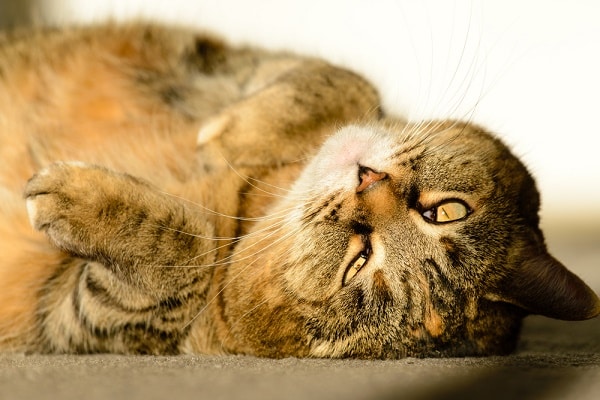You noticed that your senior cat’s fur has been looking pretty scruffy lately. He’s been eating like crazy, but he’s still losing weight. He’s suddenly acting hyper and crying in the night, and when you go to clean the litter box, it’s flooded with pee. You know something’s wrong, that it’s a health issue, so you take Fluffy to the vet. A blood test reveals that he has feline hyperthyroidism. So, what do you do about hyperthyroidism in cats?
First, you have to understand what you’re dealing with. Here are some questions and answers to get you started.
1. What are the thyroid glands?
Cats with hyperthyroidism tend to look pretty scruffy. Photography by Suphaksorn Thongwongboot / Shutterstock.
The thyroid glands are two tiny bits located on either side of your cat’s trachea (windpipe). Their job is to produce hormones that affect many of the body’s functions, but governing the rate at which your cat’s body burns energy is the most important when we’re discussing hyperthyroidism.
2. What goes wrong in feline hyperthyroidism?
A tumor grows on the thyroid glands and causes the body to produce too much thyroid hormone, which makes your cat’s body burn energy too quickly.
3. What are the symptoms of hyperthyroidism in cats?
Because your cat’s body is burning energy too quickly, the first thing you’ll probably notice is that your cat is always hungry and is losing weight in spite of his massive food consumption. He’ll also be drinking and urinating too much. Hyperthyroidism can produce behavior changes such as increased activity and restlessness, and sometimes even aggressiveness. Your cat’s fur will start looking greasy and unkempt.
4. How is hyperthyroidism in cats diagnosed?
Your vet will perform a blood test that measures the levels of thyroid hormones in your cat’s blood. If the levels of those hormones are high, your cat is hyperthyroid.
5. What treatments are available for feline hyperthyroidism?
There are three common forms of treatment for hyperthyroidism in cats: medication, radioactive iodine therapy and surgery. All three have risks and benefits.
- Medication — typically methimazole (Tapazole) here in the United States — decreases the level of thyroid hormone in your cat’s blood. It is available as a pill or in the form of a gel, which is applied to your cat’s skin. Most cats tolerate methimazole pretty well. Medication seems like the least expensive option, but in the long run the costs can add up.
- Radioactive iodine (I-131) therapy is considered the gold standard of treatment, but you may have trouble finding a clinic that offers it within a reasonable distance. It is pretty expensive, but the good news is that once the treatment is done, your cat’s hyperthyroidism is cured.
- Surgery to remove the thyroid gland is an option, but it may not solve the problem. There may be tumor cells in other parts of your cat’s body that continue to overproduce thyroid hormone, or removal of the gland could mean he’ll no longer produce enough thyroid hormone and will have to be on medicine for the rest of his life.
6. What about prescription food for hyperthyroid cats?
This food is designed to be too low in iodine, a chemical that helps the thyroid glands produce hormones. It’s being heavily marketed to vets and cat lovers, but among the vets I know, there’s a good deal of controversy about whether it has been adequately studied and what effects the lack of iodine might have on a cat’s overall health.
7. What are the complications of hyperthyroidism in cats?
Feline hyperthyroidism can disguise other conditions like kidney disease, because “running too hot” improves kidney function. Some other possible complications include high blood pressure, heart problems and difficulty breathing.
Hyperthyroidism in cats is a disease that can be managed, but it requires commitment on your part and good communication between you and your veterinarian.
Do you have a cat with hyperthyroidism? Which treatments have you tried, and how did they work out for you? Are there support groups you’d recommend? Please share your experiences in the comments.
Thumbnail: Photography by John E Heintz Jr. / Shutterstock.
About JaneA Kelley: Punk-rock cat mom, science nerd, animal shelter volunteer, and all-around geek with a passion for bad puns, intelligent conversation, and role-play adventure games. She gratefully and gracefully accepts her status as chief cat slave for her family of feline bloggers, who have been writing their cat advice column, Paws and Effect, since 2003. JaneA dreams of making a great living out of her love for cats.
Read more about cat health care on Catster.com:


